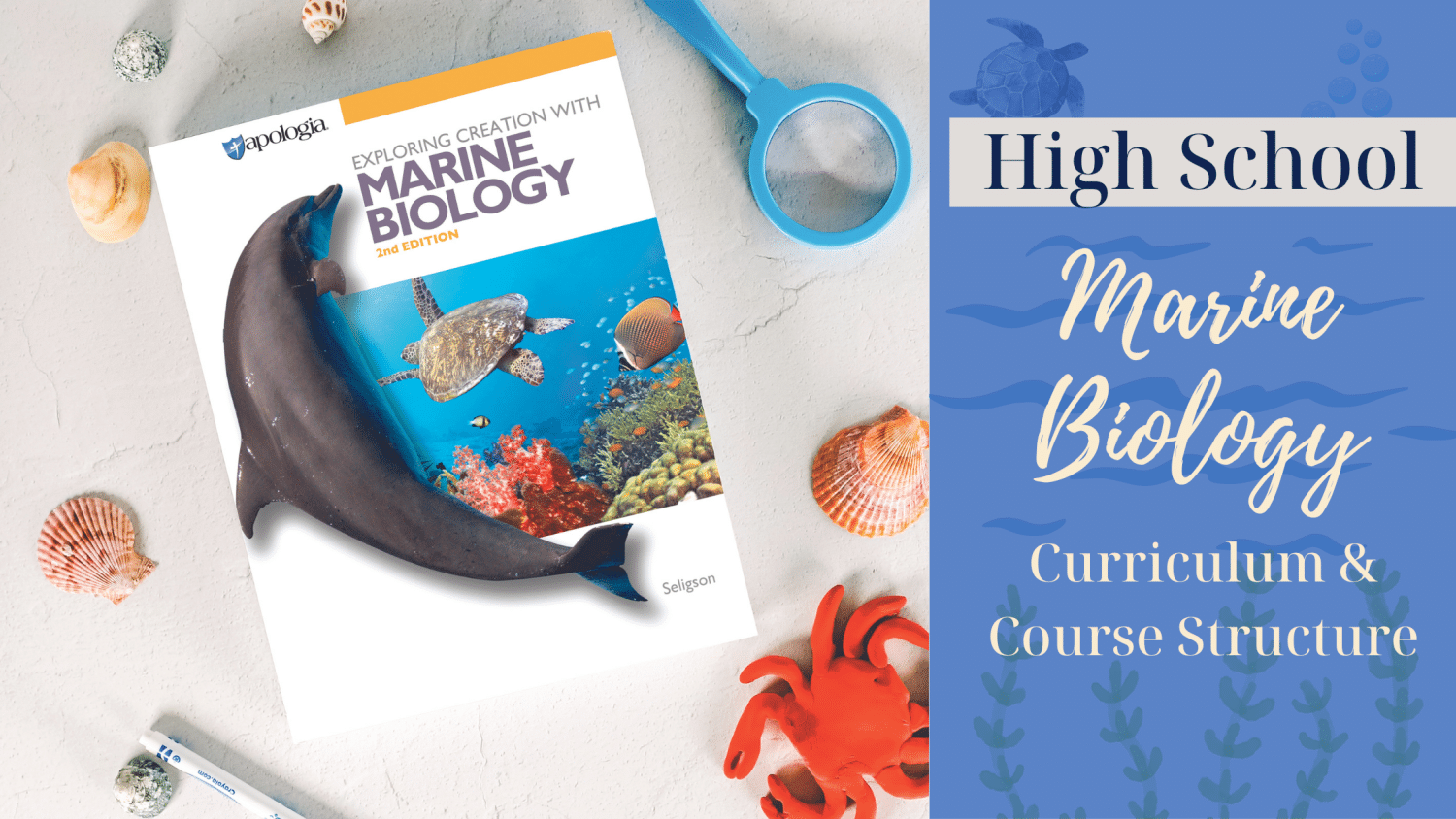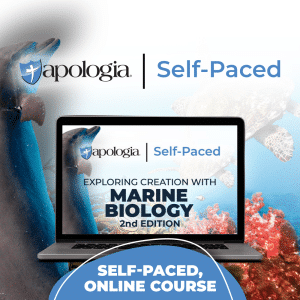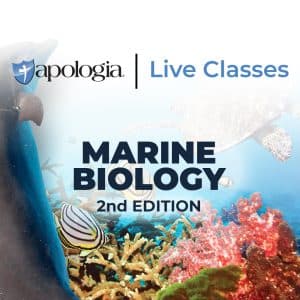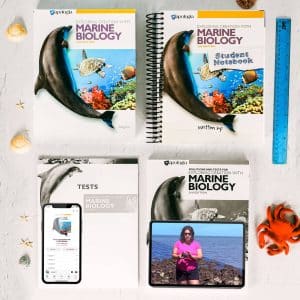
High School Marine Biology: Curriculum & Course Structure
Homeschooling your children doesn’t have to be a chore – especially when it comes to teaching marine biology. You can make it easier for yourself with help from Apologia’s marine biology curriculum for high school students. Within our 16 modules, your child or children will navigate the deep ocean and develop a better understanding of its ecosystem and resources, as well as the effects humans have on marine biology.
Watch this sample video lesson of Module 1.
The 16 modules in our marine biology curriculum include the following:
Module 1: The Oceans of Our Planet
In the first module of the course, students will learn all about the Earth’s structure and the geography of our oceans. They’ll also take a look at:
- Continental drift and plate tectonics
- Features of the ocean bottom and the properties of water
- Light and pressure in the sea
- Practical experiments that convey the Coriolis Effect and the motion of waves
- Tides and vertical motion
Module 2: Life in the Sea
The process of life in the sea is an important topic for students to learn and understand, which is why Module 2 explores:
- Photosynthesis and respiration
- Cells
- Levels of Organization
- Challenges faced by living creatures in the sea
- Temperature
- Asexual and sexual reproduction in the sea
- How we classify life in the sea
Module 3: The First Four Kingdoms
Kingdoms in marine biology refer to a hierarchical classification system that helps scientists understand the extensive diversity of life in all its forms. Kingdoms are the second-highest rank (meaning they are the second broadest) – demonstrating just how these species are related to each other through common ancestors. Module 3 of the curriculum takes a deep dive into:
- Kingdom Monera, Kingdom Protista, Kingdom Fungi, Kingdom Plantae
- Green, brown, and red algae
- Reproduction of multicellular algae
- The seagrasses
- Saltwater marsh plants
- The mangroves
Module 4: Marine Invertebrates I
Marine invertebrates are animals that inhabit the sea and don’t have a backbone. They take up a large proportion of macroscopic life in the ocean, and are the most diverse group. Module 4 will look at:
- Phylum Porifera and Cnidaria
- Class Hydroza, Scyphozoa, and Anthozoa
- The Bilateral Worms
- Phylum Platyhelminthes
- Phylum Nemertea, Nematoda, & Annelida
- Polychaeta
Module 5: Marine Invertebrates II
Following Module 4, Module 5 will explore:
- Phyllum Mollusca, Anthropoda, Echinodermata, Chordata
- Mollusk biology
- Class Asteroidea, Ophiuroidea, Echinoidea, Holothuroidea, Crinoidea
- Echinoderm biology
Check out this flip-through of the Exploring Creation with Marine Biology, 2nd Ed. course textbook.
Module 6: Marine Vertebrates I
Unlike marine invertebrates, vertebrates are animals that live in the sea and have a backbone or vertebral column. Thanks to this structure, these animals have the capacity for more movement. Students will be introduced to these types of animals in Module 6, as well as:
- Class agnatha and chondrichthyes
- Rays, skates, and bony fishes
- Different types of fish scales
- The biology of fishes
- Coloration in fishes
- Locomotion
- Reproduction in fishes and social behaviour
Module 7: Marine Vertebrates II
In continuation of Module 6, Module 7 explores:
- Class reptila, aves, mammalia
- Order cetacea, sirenia, pinnipedia, carnivora
- Echolocation and movement in the water
- Gulls and similar birds
- Penguins
- Birds at the shore
Module 8: Marine Ecology
The study of marine ecology is a topic within science that studies marine organisms, how they interact with each other, and their relationships within the ocean environment. In Module 8, students will cover topics like;
- The ecosystem and population growth
- Predator and prey relationships
- Symbiosis
- Trophic relationships
- Primary productivity
- The Carbon and Nitrogen Cycles
- Environmental Zones
Module 9: The Intertidal Zones
Intertidal zones describe the coastal areas between high and low tide lines, specifically the temporary moments when they are either submerged in water or exposed to air. As part of Module 9, students will explore:
- Intertidal communities
- Abiotic conditions
- Intertidal feeding and reproduction
- Wave action and surviving the waves
- The upper, middle, and lower intertidal zones
Module 10: Estuary Communities
Estuaries are bodies of water where rivers meet the sea. Due to their environment, they provide homes for a diverse array of wildlife, including a wide range of fish species. In Module 10, students will take a look at estuaries, including:
- The different types
- Abiotic factors in estuaries
- Estuarine communities
- Estuarine habitats and wetlands
- Estuary production, channels, mudflats
Check out this flip-through of the Exploring Creation with Marine Biology, 2nd Ed. Student Notebook.
Read more: Our High School Chemistry Curriculum
Apologia makes high school chemistry for homeschooling students that much simpler. It’s suitable for all learning styles, including auditory (audiobook), reading/writing learners (textbook/snotebook), hands-on (experiments), and visual (video lessons and experiments) learners.
By covering the fundamentals of chemistry in 16 modules (approximately 2 weeks per module), students will gain a deeper understanding of the subject through both practical and theoretical applications. Students will also have the opportunity to review questions and practice problems at the end of each module.
Module 11: Coral Reefs
A type of underwater ecosystem, coral reefs are vibrant and colourful, often referred to as the ‘rainforests of the sea.’ As they are extremely biodiverse, they support a wide variety of marine species. As part of Module 11, students will take a look at this and:
- Coral reef requirements and locations
- Reef composition
- Coral reef formation and growth
- Types of reefs
- Ecology of coral reefs
- Reef symbiotic relationships
Module 12: Continental Shelf Communities
Within the submerged edges of continents live diverse groups of marine plants and animals. These are known as continental shelf communities. Thanks to the ample sunlight and nutrient availability these environments provide, they offer important habitats for many different species. In Module 12, students will explore this and:
- Physical features of the Continental Shelf
- Soft-bottom and hard-bottom shelf communities
- Vegetated and unvegetated shelf-bottom environments
- Kelp beds, forests, and sea urchins
Module 13: The Epipelagic Zone
The topmost layer of the ocean is known as the epipelagic zone. As it is provided with sufficient sunlight, it enables photosynthesis to occur, and therefore encourages the growth of phytoplankton and other larger organisms. Module 13 of the marine biology curriculum explores this, as well as:
- Life in the epipelagic zone
- Epipelagic phytoplankton, zooplankton, and nekton
- Vertical migration
- The epipelagic food web
- Nutrients and productivity
Module 14: The Deep Ocean
In a module of its own, students will discover more about the deep ocean. This includes the Mesopelagic zone, its food webs, and its body design. The module will also explore:
- The deep-sea floor
- Hydrothermal vents
- Other vent communities
- Deep-sea photosynthesis
Module 15: Ocean Resources
The ocean is endless, and so are its resources. Module 15 of our marine biology curriculum takes a closer look at the food from the sea and its locations, as well as:
- Different food species
- Managing populations
- Mariculture
- Other living resources
- Nonliving ocean resources
Check out this flip-through of the Exploring Creation with Marine Biology, 2nd Ed. Solutions Manual and Tests.
Module 16: Effects of Humans on the Sea
In the final module, students will assess the effects the human species has on the sea, including:
- Ocean habitat damage
- Effects on coral reefs
- Pollution
- Sewage
- Fertilizers
- Oil
- Synthetic pollutants
- Other toxic chemicals
Teach High School Marine Biology From Home With Apologia
Our high school marine biology curriculum is crafted with strong, faith-based principles, incorporates hands-on experiments, and is a comprehensive, college-prep level course. Exploring Creation with Marine Biology, 2nd Ed. is also available through our live class and self-paced course options







